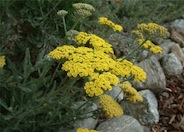
Common name:Yarrow, Cloth of Gold
Botanical name:Achillea 'Moonshine'
Long, straight stems with pale yellow flowers are apparent on the mats of green to grey-green leaves of this plant, which are flatter and less divided than those of the Achillea millefolium. The yarrow propagate easily from rooted cuttings or division, which should be performed in the early spring or fall. Following bloom, one should dead head the plant and divide the clumps when it appears crowded.
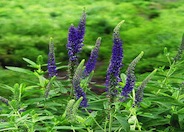
Common name:Veronica, Goodness Grows
Botanical name:Veronica 'Goodness Grows'
'Goodness Grows' is a blue flowering veronica. It blooms longer than all the veronicas, which makes it an excellent container plant.
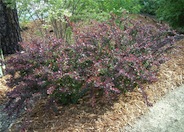
Common name:Japanese Barberry, Crimson Pygmy
Botanical name:Berberis thunbergii 'Crimson Pygmy'
Pygmy purple leaf barberry is a deciduous shrub with arching branches which reaches 2 ft high and 3 ft wide. The foliage becomes bronzy red in summer and fall. 'Crimson Pygmy' prefers full sun and regular watering, more in hot summer months. This plant has thorns. It makes a great hedge. Prune in winter to re-shape.
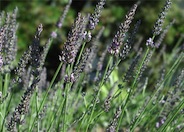
Common name:Lavender, English
Botanical name:Lavandula angustifolia
A well-developed woody base is apparent with this evergreen subshrub. Its leaves assume an obtuse form, and have a grey-green color above and a white tomentose shade below. It is fragarant and needs little water, full sun, and well drained soils.
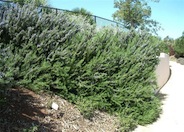
Common name:Rosemary
Botanical name:Rosmarinus officinalis
Rosemary is hardy in full sun areas where winter temperatures do not drop below 10 degrees F. Rosemary is evergreen and makes a great aromatic hedge, 4'-6' tall and 2' wide. Foliage is used in cooking. Blue flowers appear in summer. This plant is drought tolerant once it's established. Bees love Rosemary!
The Magic of Mulch
In the natural world the endless cycle of birth, growth, decay, death and rebirth flows throughout the seasons. Plants die, leaves fall and new growth springs up in its place. Nothing is lost and the fallen leaves and dead plants decay into the soil, enriching it for the next generation of growth.
Click in the green box for more information
| Designer: Solid Ground Garden | Solid Ground 3 |
Photographer: GardenSoft |
Soils and Compost:
Maintain a two to four inch layer of mulch on the soil surface to reduce weeds, infiltrate rain water, and reduce compaction.
Water Saving Tip:
Integrated Pest Management:
Attract, or buy beneficial insects such as ladybugs and lacewings to control pest outbreaks in your garden.
